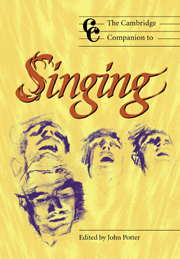1 - Introduction: singing at the turn of the century
Published online by Cambridge University Press: 28 September 2011
Summary
Singing moves and excites people, often in very large numbers. Thousands turn out for the Three Tenors or rock concerts, millions mourned Frank Sinatra and the Berber singer Lounès Matoub; every week in Europe millions more sing their hearts out at football matches. We are born into a babble of voices and the clamour continues, if we're lucky, for the rest of our lives: our voices are us, directly expressive of our personalities and emotions. A voice is not like an oboe or violin, something you can take out of its case and put away, an instrument with hundreds of years of technical development behind it. You don'st have to be a virtuoso to express your own emotions. Everyone can speak, and everyone can sing, so we all have our own idea of what singing actually is. This is one reason that the Cambridge Companion to Singing is different from its instrumental predecessors: in the end a choice has to be made about which aspects of singing can be usefully explored in the space available. Like the other Companions, this one deals almost exclusively with the music we experience in the industrialised West. At the beginning of a new century, with artistic ideas and activities expanding in all directions, it seems appropriate to begin with ‘world music’. The term is a Western concept, involving the incorporation of singing outside the Western tradition into the stream of possibilities that are available to us today.
- Type
- Chapter
- Information
- The Cambridge Companion to Singing , pp. 1 - 6Publisher: Cambridge University PressPrint publication year: 2000
- 2
- Cited by

